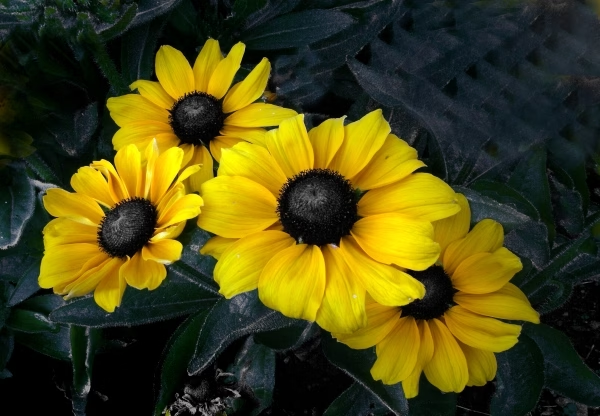
Black-eyed Susan
Botanical Name
:
Rudbeckia hirta
Plant Type
:
Flowering perennial; sometimes short-lived
Seasons
:
Spring planting (after last frost), blooms in summer through fall
Sun Level
:
Full sun (at least 6 hours daily)
Ideal Soil Temperature for Planting
:
60-70°F (15–21°C)
Soil Type
:
Well-drained, tolerant to poor soil
Hardiness Zones
:
3–9 (USDA)
Germination
:
7–14 days
P.H. Level
:
6.0–7.0 (slightly acidic to neutral)
Water/Irrigation
:
Water regularly, especially during the first year and dry periods. Once established, they are somewhat drought-tolerant
Fertilization
:
Not typically needed, but a light application of balanced fertilizer with moderate levels of nitrogen in spring can be beneficial. Over-fertilizing can lead to excessive foliage and fewer flowers
Habit
:
Upright, branching
Propagation
:
Seed, division (of established clumps in spring or fall)
Final Plant Height
:
1–3 ft
Spread
:
1–2 ft
Flowers
:
Daisy-like, with yellow, red, or orange petals and a dark brown or black central cone
Attracts
:
Butterflies, bees, and other pollinators
Uses
:
Ornamental (garden beds, borders, cut flowers), medicinal (historically, some Native American tribes used the roots for various ailments, but this is not recommended without expert guidance)
Companions
:
Coneflowers (Echinacea), Yarrow (Achillea), Salvia, ornamental grasses
Pruning
:
Deadheading (removing spent flowers) encourages more blooms. Cut back stems in late fall or early spring
Toxicity
:
Generally considered non-toxic to humans and animals
Pests
:
Aphids, slugs, snails, Japanese beetles
Diseases
:
Powdery mildew, leaf spots, and rust
Fun Fact
:
The dark center of the flower head is actually made up of many tiny individual flowers
Confused With
:
Other Rudbeckia species, sometimes with similar-looking daisies like coreopsis
Additional Info
:
Native to North America. The “hirta” in the botanical name means “hairy,” referring to the hairy stems and leaves
Botanical Name
:
Rudbeckia hirta
Plant Type
:
Flowering perennial; sometimes short-lived
Seasons
:
Spring planting (after last frost), blooms in summer through fall
Sun Level
:
Full sun (at least 6 hours daily)
Ideal Soil Temperature for Planting
:
60-70°F (15–21°C)
Soil Type
:
Well-drained, tolerant to poor soil
Hardiness Zones
:
3–9 (USDA)
Germination
:
7–14 days
P.H. Level
:
6.0–7.0 (slightly acidic to neutral)
Water/Irrigation
:
Water regularly, especially during the first year and dry periods. Once established, they are somewhat drought-tolerant
Fertilization
:
Not typically needed, but a light application of balanced fertilizer with moderate levels of nitrogen in spring can be beneficial. Over-fertilizing can lead to excessive foliage and fewer flowers
Habit
:
Upright, branching
Propagation
:
Seed, division (of established clumps in spring or fall)
Final Plant Height
:
1–3 ft
Spread
:
1–2 ft
Flowers
:
Daisy-like, with yellow, red, or orange petals and a dark brown or black central cone
Attracts
:
Butterflies, bees, and other pollinators
Uses
:
Ornamental (garden beds, borders, cut flowers), medicinal (historically, some Native American tribes used the roots for various ailments, but this is not recommended without expert guidance)
Companions
:
Coneflowers (Echinacea), Yarrow (Achillea), Salvia, ornamental grasses
Pruning
:
Deadheading (removing spent flowers) encourages more blooms. Cut back stems in late fall or early spring
Toxicity
:
Generally considered non-toxic to humans and animals
Pests
:
Aphids, slugs, snails, Japanese beetles
Diseases
:
Powdery mildew, leaf spots, and rust
Fun Fact
:
The dark center of the flower head is actually made up of many tiny individual flowers
Confused With
:
Other Rudbeckia species, sometimes with similar-looking daisies like coreopsis
Additional Info
:
Native to North America. The “hirta” in the botanical name means “hairy,” referring to the hairy stems and leaves
Written by Nondiah Khalayi – https://www.linkedin.com/in/nondiah-khalayi/

